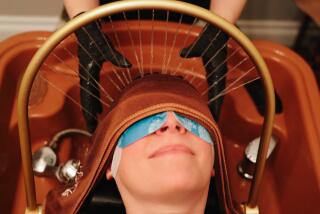SCIENCE / MEDICINE : Swelled Head First Step in Surgical Baldness Cure
- Share via
The search for a cure for baldness has taken many devious routes throughout history.
The most common approach has been the “magic ointment.” In their search for a luxuriant head of hair, men have rubbed their scalps with an exotic array of potions, including python fat, date seeds boiled in oil, and salt and quinine in brandy.
That approach eventually culminated in the marketing of the prescription drug minoxidil, which does produce hair, or at least fuzz, if used conscientiously for the life of the grower.
Surgeons have been somewhat more successful. In general, their approach has been to take hair from where it is and put it where it isn’t.
The best-known surgical technique is a hair transplant, in which “plugs” of hair and scalp are taken from the fringe on the side of the head and transplanted into the scalp.
Now, plastic surgeon Ernest Manders of the Milton S. Hershey Medical Center in Hershey, Pa., has developed a new technique that is simpler and faster than transplantation. The technique seems an ideal way to spread hair more evenly over the top of the head--as long as the patient doesn’t mind walking around with, literally, a swelled head, for a couple of months.
The new method is particularly useful for victims of trauma, cancer and burns who need hair replacement in the affected areas, and is being increasingly used for such applications. “It’s a good technique,” said Dr. Charles Vallis, a plastic surgeon at Harvard Medical School.
But it is also valuable for men who have lost a great amount of hair to male pattern baldness and who want to replace it because of the aesthetic needs of their occupation. Some television and movie actors have already undergone the procedure.
The technique relies on skin’s flexibility and ability to expand readily. When an individual gains weight, for example, the area of the skin increases to accommodate the added mass.
To expand skin, physicians loosen a segment of skin from its underlying foundation and insert a silicone bag. Over a period of weeks, they inject saltwater into the bag to enlarge it a little bit at a time, and the skin stretches to accommodate it. When enough extra skin is available, physicians deflate and remove the bag and transplant the excess skin.
Manders came upon the hair-restoring technique while expanding skin on the scalp and forehead to repair noses injured in accidents. In the process, he observed that hair continued to grow in the expanded skin, but that the individual hair follicles were spaced farther apart. The discovery led him to try the technique as a baldness cure.
In the procedure, Manders separates the scalp from the underlying skull and implants the silicone bag. Although the procedure is performed under an anesthetic, it is relatively painless because nerves and blood vessels are in the scalp itself and not severed, Vallis said.
The patient returns to the physician’s office each week to have saltwater injected into the bag. This process can take two to four months, depending upon how large an area needs to be replaced. The swelling varies from modest to mammoth, if a large bald spot needs to be covered.
When the scalp has expanded sufficiently, the physician removes the bag, cuts out the bald spot, pulls the hair together to the center of the scalp, and stitches it in place.
The surgery costs $3,000 to $7,000, depending on the area to be covered.
SURGICAL RECONSTRUCTION TO CURE BALDNESS
Ideal candidates are men with male pattern baldness, plenty of hair on the sides, but none on top. Inflatable silicone bags are surgically implanted beneath the scalp.
Over the next two to four months, the bags are gradually inflated with salt water, causing the hairy scalp to bulge. The bags are then removed and the bald dome is cut away.
The expanded scalp is pulled up and surgically sewn, giving the patient a full head of hair.





